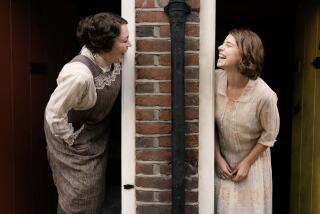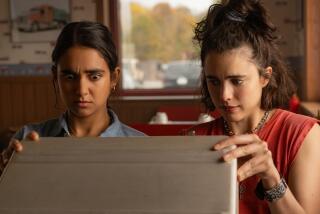MOVIE REVIEW : LOVE’S GOT NOTHING TO DO WITH ‘RITA, SUE & BOB’
- Share via
Nothing quite prepares you for the first 10 or so minutes of “Rita, Sue and Bob, Too!” (Cineplex, Beverly Center), set in Britain’s depressed industrial north. Rita and Sue, 16-year-old schoolgirls, best chums and virgins both, are invited to drive the long way home with the 30-ish Bob (George Costigan), whose kids they’ve been baby-sitting.
It’s “love” on the mist-encircled moors, but it has nothing whatever to do with Heathcliff--or love, for that matter. Having chatted them up as he drives, enquiring brashly whether they’re courting yet, Bob explains that things ha’nt been goin’ on well w’ Michelle, the wife.
“Tell us anoother one,” Rita jeers, but Bob’s air of roguish confidence intrigues both girls. With very little preamble, in this blue-black darkness with only the car’s dome light for illumination, first Sue, then Rita are given a hands-on demonstration in the art of safe, if highly unprivate, sex.
It could be a well-nigh unbearable scene (and for some it may still be) if it weren’t for the amazing personalities of the two actresses, Siobhan Finneran as Rita, Michelle Holmes as Sue--strapping, marvelous heroines. Spirited, practical and in total solidarity, they take to sex as ducklings take to the pond--and with about as much cheerful racket. (The movie’s R rating is for nudity, sex and uninhibited language.)
Thus begins an irrepressible threesome with far-reaching consequences. Screenwriter Andrea Dunbar (who wrote the original material first as two short plays) makes it very clear that the future here in Bradford is dismal. Sue has a dead-end job dispatching taxis; Rita is threatening to leave high school only weeks before graduating. If, after his marital upsets, Bob’s proposition to both girls is frankly outrageous, we can also see his tidy middle-class house through their eyes, and it looks palatial.
One of the more memorable things about “Rita, Sue” is that it makes its sociological points quietly, with humor, or not at all. Rita and Sue’s council flats are seedy and trash-strewn, intimately observed--screenwriter Dunbar grew up and still lives in one of those cement blockhouses, the kind given tony names like Lazenby House or Buttershaw Estates.
Dunbar and director Alan Clarke capture these in fast, funny snapshots: an old “gummer” on a neighboring balcony, so carried away watching a domestic fracas that he does deep knee bends in empathy. Rita, snatched by her biker-brothers from the furious hands of Bob’s wife, is carried off to the safety of the family flat--where her father begins to swat her. The movie’s tone is light, absurd; its sharper comments lie a little below the waterline.
When for a while things become strained between Rita and Sue, Sue succumbs to an earnest young Pakistani (Kulvinder Ghir), which brings the withering prejudices of both council flats and middle-class suburbs to the fore. In Bob’s tidy, prying community, flagrant extramarital hanky-panky is one thing, but a Paki in the front yard is reason enough to call the police.
Perhaps the most astounding sequence takes place at a noisy local nightclub, where Bob has taken both the girls. Led by the sleaziest pair of entertainers in all Yorkshire, the whole room joins in one of those hearty English dances like that classic mainstay, the Okey Pokey. Except that the whole roomful of stolid Brits are singing: “We’re havin’ a gang bang, we’re havin’ a ball, we’re havin’ a gang bang, against the wall.”
Lighting cameraman Ivan Strasburg inventories these cheery, flushed faces--energetic grannies, mums and dads, all bumping bosoms and bottoms tirelessly--for some sign that anyone has a clue as to what they’re singing about, but they’re bland as buttermilk. In this moment of true absurdity, anyone who quibbles about a little straightforward lust has his work cut out for him.
More to Read
Only good movies
Get the Indie Focus newsletter, Mark Olsen's weekly guide to the world of cinema.
You may occasionally receive promotional content from the Los Angeles Times.









